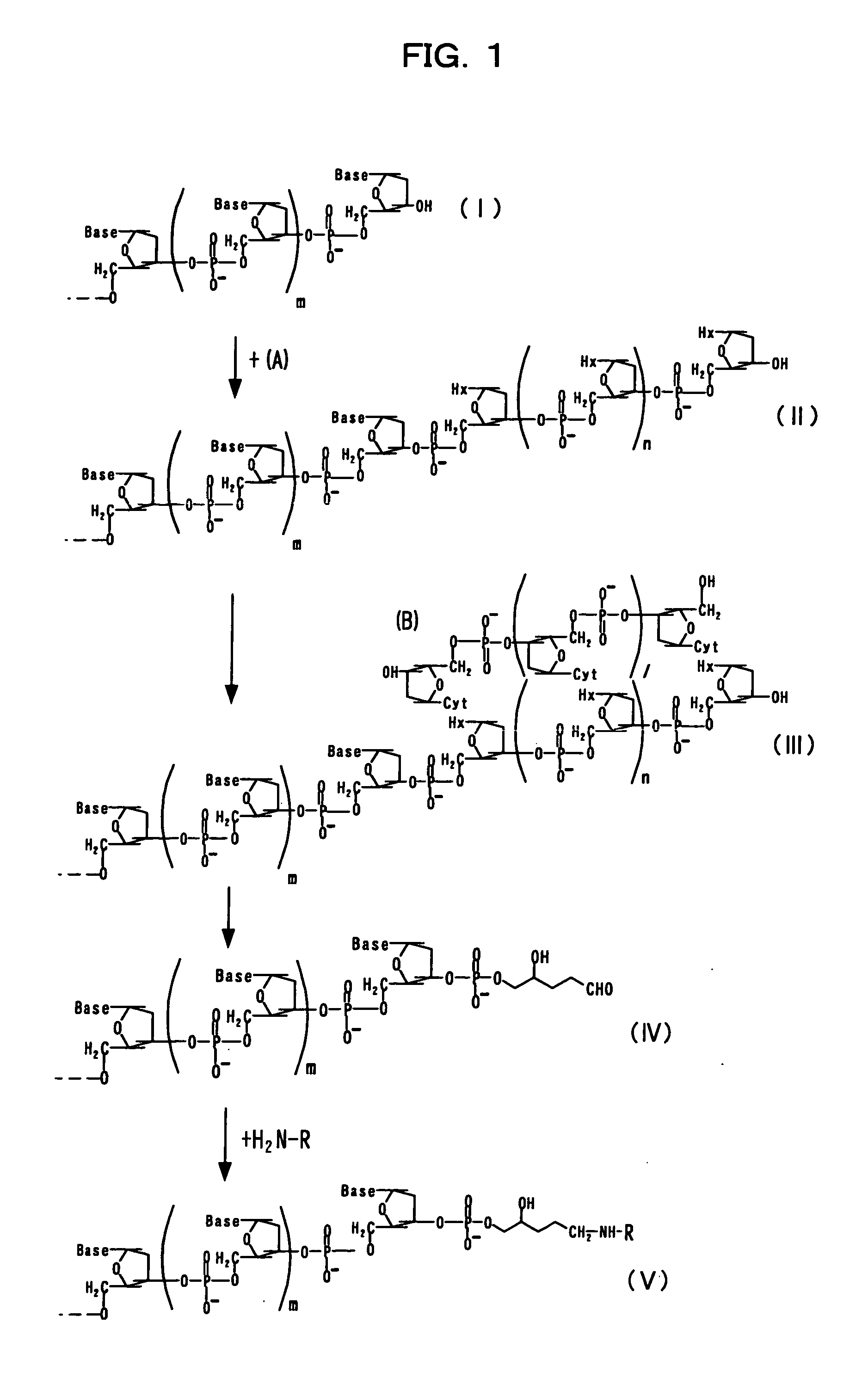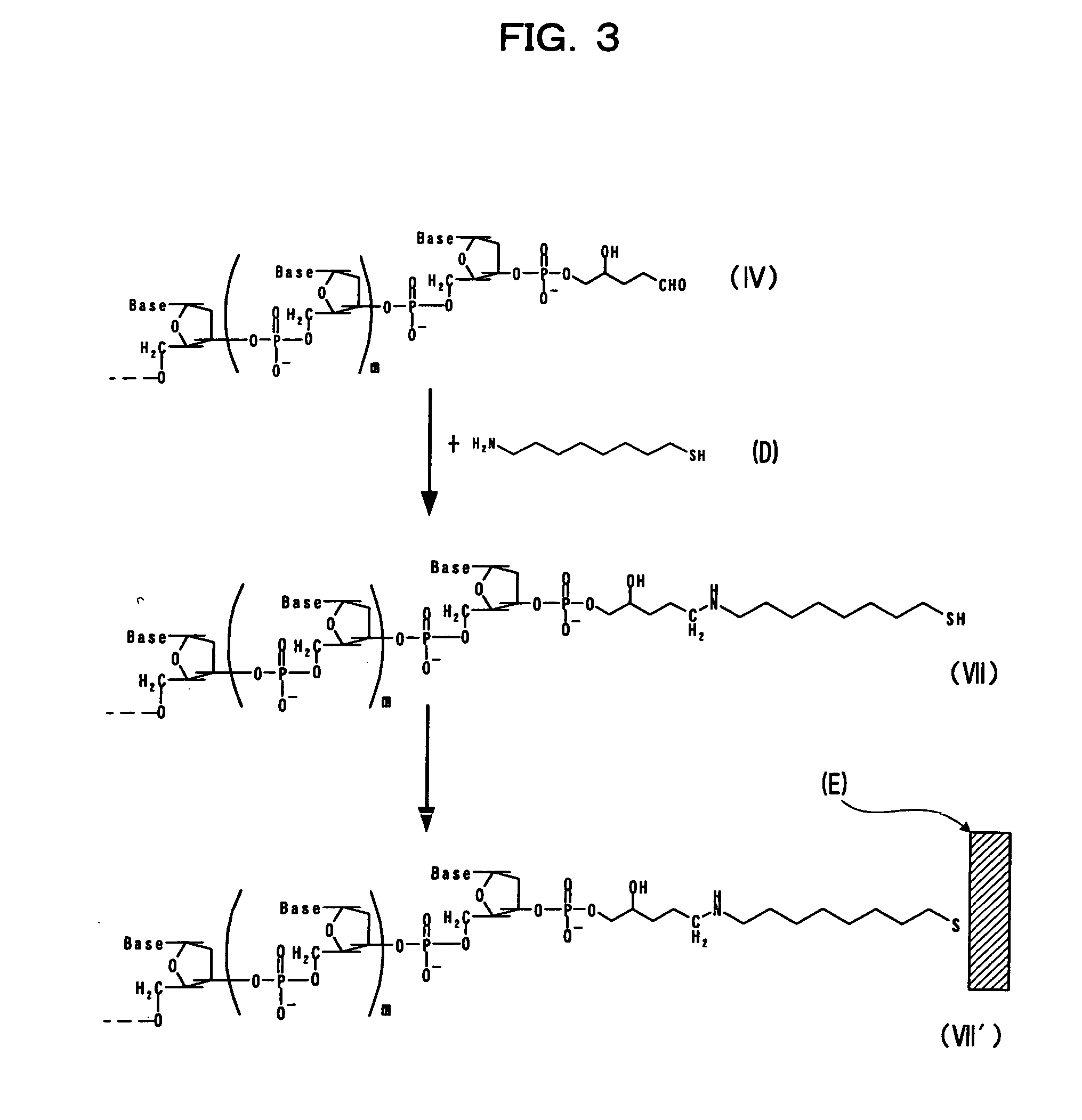Method for modifying nucleotide chain
a nucleotide chain and nucleotide technology, applied in the field of nucleotide chain modification, can solve the problems of unstable modification state, limited use duration of radioisotopes, alkalinity phosphatase, etc., and achieve stable and strong immobilization, labeling or conjugating the nucleotide chain is easy.
- Summary
- Abstract
- Description
- Claims
- Application Information
AI Technical Summary
Benefits of technology
Problems solved by technology
Method used
Image
Examples
embodiment 1
(Embodiment 1)
[0093] Embodiment 1 of the present invention will be described based on FIG. 1. In the figure, each of 1, m, and n represents null or any given natural number. The term “Base” represents any given base such as adenine, guanine, cytosine, thymine, uracil, or the like. Hx represents hypoxanthine, and Cyt represents cytosine.
[0094] Terminal deoxynucleotidyltransferase is allowed to act on a nucleotide chain (I) having any given nucleotide sequence and 2′-deoxyinosine-5′-triphosphate (A) (which has hypoxanthine Hx, as shown in the structure indicated below), so as to add a nucleotide sequence including hypoxanthine to the 3′-terminus of the nucleotide chain (I), thereby obtaining a nucleotide chain (II).
[0095] An oligonucleotide chain (B) consisting of several dozens of nucleotides including cytosine is annealed to the obtained nucleotide chain (II), so as to obtain a nucleotide chain (III).
[0096] Thereafter, 3-methyladenine DNA glycosylase II is allowed to act on the ...
embodiment 2
(Embodiment 2)
[0117]FIG. 4 shows the principle of the method for modifying a nucleotide chain in Embodiment 2 of the present invention. FIG. 5 shows a chemical equation of the reaction center of the nucleotide chain shown in FIG. 4.
[0118] In FIGS. 4 and 5, N0 represents any base selected from the group consisting of adenine, guanine, thymine, and cytosine. N1 represents any base selected from the group consisting of adenine, guanine, thymine, and cytosine, which forms a complementary base pair with N0. N2 represents any base selected from the group consisting of adenine, guanine, thymine, and cytosine, which does not form a complementary base pair with N0. N3 represents any base selected from the group consisting of adenine, hypoxanthine, thymine, and cytosine, which forms a complementary base pair with N2. C represents cytosine, and Hx represents hypoxanthine. All of these N0, N1, N2, N3, C, and Hx are included in 2′-deoxynucleotide (hereinafter referred to simply as nucleotide) ....
embodiment 3
(Embodiment 3)
[0125]FIG. 6 shows the principle of the method for modifying a nucleotide chain in Embodiment 3 of the present invention. This method comprises addition of a nucleotide sequence including hypoxanthine acting as a substrate to the aforementioned 3-methyladenine DNA glycosylase II, to a nucleotide chain as a target for modification out of a double-stranded nucleotide.
[0126] In the figure, N0, N1, N2, C, Hx, 5′, and 3′ have the same meanings as described above. N4 represents any base selected from the group consisting of adenine, guanine, thymine, and cytosine, which forms a complementary base pair with N2. A represents adenine, G represents guanine, and T represents thymine, respectively.
[0127] The double-stranded nucleotide consists of a first nucleotide chain (2-11) and a second nucleotide chain (2-12). Of these, the nucleotide chain (2-11) is a target for modification. The nucleotide chain (2-11) has the sequence of base N0 in the 3′-terminal region thereof. The nuc...
PUM
 Login to View More
Login to View More Abstract
Description
Claims
Application Information
 Login to View More
Login to View More - R&D
- Intellectual Property
- Life Sciences
- Materials
- Tech Scout
- Unparalleled Data Quality
- Higher Quality Content
- 60% Fewer Hallucinations
Browse by: Latest US Patents, China's latest patents, Technical Efficacy Thesaurus, Application Domain, Technology Topic, Popular Technical Reports.
© 2025 PatSnap. All rights reserved.Legal|Privacy policy|Modern Slavery Act Transparency Statement|Sitemap|About US| Contact US: help@patsnap.com



